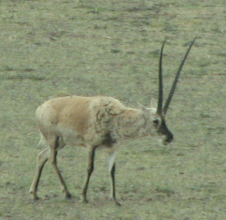ചീരു
തിബത്ത്പീഠഭൂമിയിൽ മാത്രം കാണപ്പെടുന്ന ഒരിനം മാനാണ് (കൃഷ്ണമൃഗം) ചീരു. വംശനാശത്തിന്റെ വക്കിലുള്ള ഇവയിൽ ഇന്ന് 75,000 എണ്ണം മാത്രമേ ബാക്കി ഉള്ളൂ. ഇവകൂട്ടം കൂടി ജീവിക്കുന്ന വർഗ്ഗമാണ്, 20 എണ്ണം വരെ ഉള്ള ചെറു കൂട്ടങ്ങൾ ആയാണ് ഇവ ജീവിക്കുന്നത്.150,000 ത്തോളം വരുന്ന ഓരോ പ്രായപൂർത്തിയായ മൃഗത്തെയും വനത്തിലേയ്ക്ക് വിട്ടതിനെതുടർന്ന് ഇപ്പോൾ ഇതിന്റെ അംഗസംഖ്യ കൂടുന്നതായി കണ്ടുവരുന്നു.[2] സമീപകാലത്ത് അനധികൃതമായി ഇവ വേട്ടയാടപ്പെടുന്നതിനാൽ ഇവയ്ക്ക് വംശനാശം വരുന്നതായി കാണുന്നു. ഇവയുടെ മൃദുവായ രോമങ്ങൾ കൊണ്ട് ഷാഹ്ടൂഷ് എന്നറിയപ്പെടുന്ന ഒരിനം ഉത്തരീയം തുന്നാൻ ഉപയോഗിക്കുന്നു.[3] ഈ ടിബറ്റൻ കൃഷ്ണമൃഗത്തിന്റെ വംശനാശത്തിന് ഇതും ഒരു കാരണമായി തീരുന്നു. ഇപ്പോൾ ഇവയിൽ നിന്നുൽപ്പാദിപ്പിക്കുന്ന വസ്തുക്കളുടെ അന്താരാഷ്ട്രവ്യാപാരം നിരോധിക്കപ്പെട്ടിട്ടുണ്ട്. ജമ്മു-കാഷ്മീറിൽ സ്ഥിതിചെയ്യുന്ന കാരക്കോറം വന്യമൃഗസംരക്ഷണ കേന്ദ്രത്തിൽ ഇവ സംരക്ഷിക്കപ്പെടുന്നു.[4]
| Tibetan Antelope | |
|---|---|

| |
| Pantholops hodgsonii | |
| ശാസ്ത്രീയ വർഗ്ഗീകരണം | |
| Domain: | Eukaryota |
| കിങ്ഡം: | Animalia |
| Phylum: | കോർഡേറ്റ |
| Class: | Mammalia |
| Order: | Artiodactyla |
| Family: | Bovidae |
| Genus: | Pantholops Hodgson, 1834 |
| Species: | P. hodgsonii
|
| Binomial name | |
| Pantholops hodgsonii (Abel, 1826)
| |

| |

വർഗ്ഗീകരണം
തിരുത്തുകഒറ്റപ്പെട്ട വർഗ്ഗത്തിലുള്ള ഈ കൃഷ്ണമൃഗം പാൻതൊലോപ്സ് ജീനസിൽ ഉൾപ്പെടുന്നതാണ്. ഗ്രീക്കിൽ എല്ലാ കൃഷ്ണമൃഗങ്ങളും എന്നർത്ഥം വരുന്ന വാക്കിൽ നിന്നാണ് ജീനസ് നാമം ഉണ്ടായത്. മുൻകാലങ്ങളിൽ ഇതിനെ വർഗ്ഗീകരിച്ചിരുന്നത് ആന്റിലോപിനേ എന്ന ഉപകുടുംബത്തിലായിരുന്നു. എന്നാൽ ബാഹ്യഘടനകളുടെ അടിസ്ഥാനത്തിൽ ഇവയെ ഉപകുടുംബമായ പാൻതോലോപിനേയിലേയ്ക്ക് മാറ്റുകയുണ്ടായി. ഗോട്ട്-ആന്റലോപ്പുകളുടെ ഉപകുടുംബമായ കാപ്രിനേയുമായി പാൻതോലോപിനേ സാദൃശ്യം കാണിക്കുന്നു.[5] എങ്ങനെയായാലും ഇതൊരു തർക്കവിഷയമാണ്.[6] ചില ഗ്രന്ഥങ്ങളിൽ പറയുന്നത് യഥാർത്ഥത്തിൽ ഇത് കാപ്രിനേ ഉപകുടുംബത്തിലെ അംഗമാകേണ്ടതാണ്. [7]
ചിത്രശാല
തിരുത്തുക-
ടിബറ്റൻ കൃഷ്ണമൃഗം
-
Use of the Chiru antlers in weapons of Tibetan Soldier about 1905
-
The antelope are killed for their wool, which is woven into the luxury fabric shahtoosh, threatening the species’ survival.
അവലംബം
തിരുത്തുക- ↑ "Pantholops hodgsonii". IUCN Red List of Threatened Species. Version 2008. International Union for Conservation of Nature. 2008. Retrieved 29 March 2009.
{{cite web}}: Cite has empty unknown parameter:|last-author-amp=(help); Invalid|ref=harv(help); Unknown parameter|authors=ignored (help) Database entry includes a brief justification of why this species is considered endangered. - ↑ Mallon, D.P. (2016). "Pantholops hodgsonii". IUCN Red List of Threatened Species. Version 2008. International Union for Conservation of Nature. Retrieved 14 January 2018. Database entry includes a brief justification of why this species is considered endangered.
- ↑ http://wwf.panda.org/what_we_do/endangered_species/tibetan_antelope/
- ↑ Karakoram Wildlife Sanctuary
- ↑ Gatsey, J.; et al. (1997). "A cladistic analysis of mitochondrial ribosomal DNA from the Bovidae". Molecular Phylogenetics and Evolution. 7 (3): 303–319. doi:10.1006/mpev.1997.0402.
- ↑ Lei, R.; et al. (2003). "Phylogenetic relationships of Chinese antelopes (subfamily Antilopinae) based on mitochondrial ribosomal RNA gene sequences". Journal of Zoology. 261 (3): 227–237. doi:10.1017/S0952836903004163.
- ↑ Grubb, P. (2005). "Order Artiodactyla". In Wilson, D.E.; Reeder, D.M. Mammal Species of the World: A Taxonomic and Geographic Reference (3rd ed.). Johns Hopkins University Press. pp. 637–722. ISBN 978-0-8018-8221-0. OCLC 62265494.
